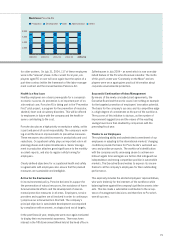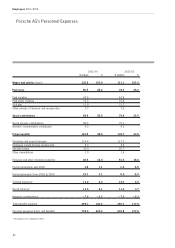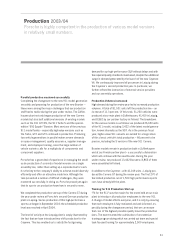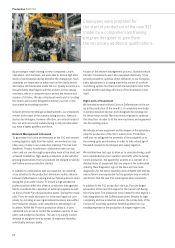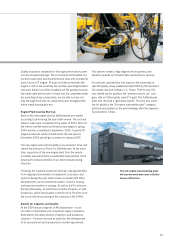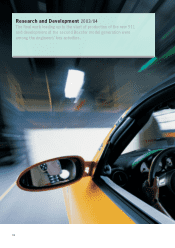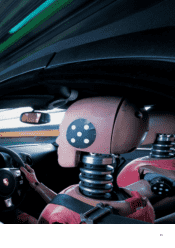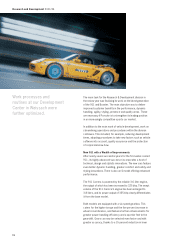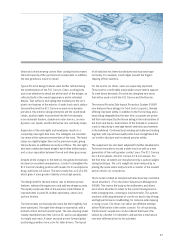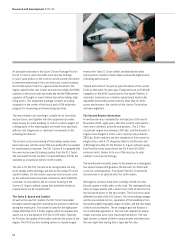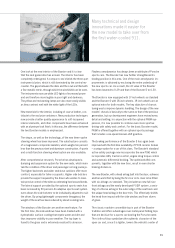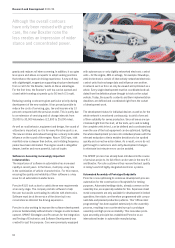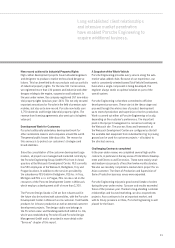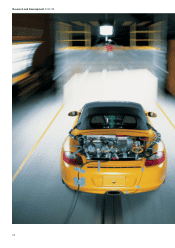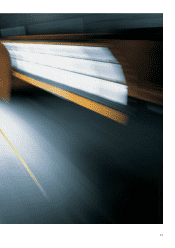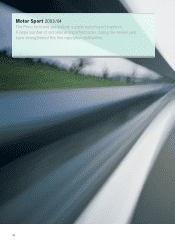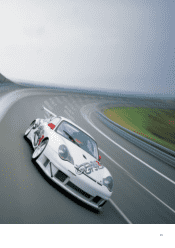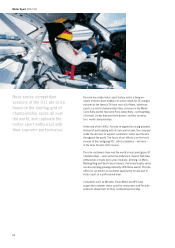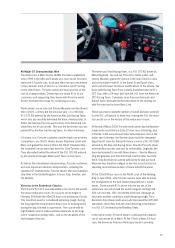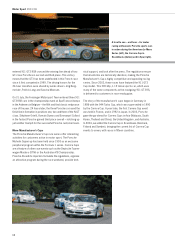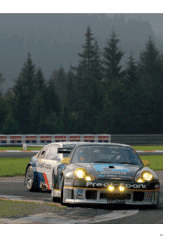Porsche 2003 Annual Report Download - page 93
Download and view the complete annual report
Please find page 93 of the 2003 Porsche annual report below. You can navigate through the pages in the report by either clicking on the pages listed below, or by using the keyword search tool below to find specific information within the annual report.
89
One look at the new interior of the Boxster and it is clear
that the next generation has arrived. The interior has been
completely redesigned. A compact cowl shields the three-part
instrument cluster, which is still dominated by the central rev
counter. The gaps between the dials and the cowl are filled with
a fine metallic mesh, through which the windshield can be seen.
The instruments now use white LED lights of increased power
and are therefore more legible in poor light and darkness.
The yellow and red warning lamps are also more easily visible,
as they contrast well with the white light of the LEDs.
New materials for the interior, including of course leather, con-
tribute to the exclusive ambience. New production techniques
now provide a better quality appearance to soft-lacquered
interior elements, and other components have been enhanced
with an aluminum-look finish. In this way, the difference between
the two Boxster models is emphasized.
The shape, as well as the technology, of the new three-spoke
steering wheel has been improved. The substructure consists
of a magnesium-composite skeleton, which weighs ten percent
less than the previous steel and aluminum construction. A sports
and a multi-function steering wheel option are also available.
After comprehensive research, Porsche has developed a
damping and suspension system for the new seats, which main-
tain the condition of the driver and passenger on long journeys.
The higher backrests and wider seat base cushions offer more
comfort, especially for taller occupants. Higher side bolsters
provide the support required by the driver who wishes to main-
tain precise control of the when accelerating hard around bends.
The lateral support provided by the optional sports seats has
been increased by 50 percent. An adaptive sports seat system
even allows the side bolsters to be individually adjusted to suit
the driver. By using lightweight components throughout, the
weight of the seat has been reduced by about six kilograms.
The windows of the Boxster are another new feature. For
the first time, the side windows have been treated with a
hydrophobic surface coating that repels water and dirt and
thus improves visibility in poor weather. The top layer is
fused to the glass and is extremely resistant to abrasion.
Flawless aerodynamics has always been an attribute of Porsche
sports cars. The Boxster has now further strengthened its
leading position in this area. One of the main aerodynamic im-
provements is obtained by enclosing the entire underbody of
the new sports car. As a result, the cD value of the Boxster
has been lowered to 0.29 and that of the Boxster S to 0.30.
The Boxster is now equipped with 17-inch wheels as standard
and the Boxster S with 18-inch wheels. 19-inch wheels are an
optional extra for both models. The key objective of chassis
tuning was to improve dynamic handling. The design of the new
models’ chassis is basically to the same as that of the previous
generation, but our development engineers have revised every
detail and setting. In conjunction with the optional PASM sus-
pension, it is now possible to combine even more sportive
driving with safety and comfort. For the basic Boxster model,
PASM is offered together with an optional sports package
that includes a six-speed manual-shift gearbox.
The braking performance of the Boxster S has again been
improved with the first-time availability of PCCB ceramic brakes
– a unique option for a car of this class. The Boxster’s standard
active safety package now incorporates the new PSM, which
incorporates ABS, traction control, engine drag torque control
and automatic differential braking. The optimized ABS com-
ponents, together with the new tires, result in even shorter
braking distances.
The new Boxster, with a head airbag built into the door, achieves
another world first by being the first car in its class to be fitted
with six airbags as standard. They include two new full-size
front airbags and the newly developed POSIP system, consis-
ting of a thorax airbag in the outer edge of the seat back and
the unique head airbag in the door trim. This effectively shields
the head from impact with the side window and from slivers
of glass.
The classic roadster convertible top is part of the Boxster
tradition and offers advantages over metal-panel folding tops
that are decisive for a sports car bearing the Porsche name.
The cloth soft top symbolizes the authentic character of the
open car and, since it is lighter, lowers the vehicle’s center of
Many technical and design
innovations made it easier for
the new model to take over from
the first water-cooled 911.


